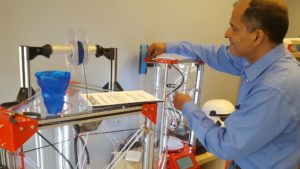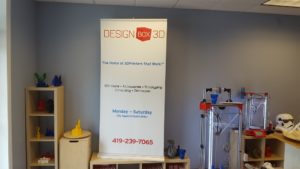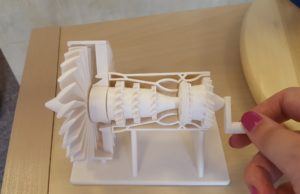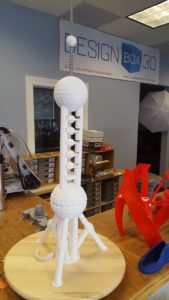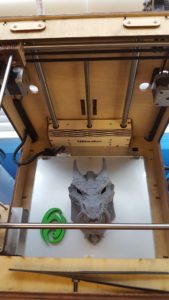Understanding 3D Printers, Customers, Suppliers Key to Distribution in 3D Printing: Inside DesignBox3D
 Desktop 3D printers, which many first imagined might see common use in the homes of the future, are increasingly finding their place in industrial, professional, and educational settings. Use of these small additive manufacturing machines is spreading, seeing use in applications from the classroom to the automotive industry — and they have to get there somehow. Distributors and resellers are an important part of the business of 3D printing, offering not only hardware and materials, but also support and direct relationships with both suppliers and customers. I recently went out to Sandusky, Ohio, which is famed for being the rollercoaster capital of the world — but I was there instead for the tech, as the city is also home to DesignBox3D.
Desktop 3D printers, which many first imagined might see common use in the homes of the future, are increasingly finding their place in industrial, professional, and educational settings. Use of these small additive manufacturing machines is spreading, seeing use in applications from the classroom to the automotive industry — and they have to get there somehow. Distributors and resellers are an important part of the business of 3D printing, offering not only hardware and materials, but also support and direct relationships with both suppliers and customers. I recently went out to Sandusky, Ohio, which is famed for being the rollercoaster capital of the world — but I was there instead for the tech, as the city is also home to DesignBox3D.
An unassuming business park just a few miles from Cedar Point houses the showroom, where I met company president Preet Jesrani. I’d run into him earlier this year at CES, as he worked there with partner ZMorph, and learned more about the business model for DesignBox3D, which at the time was solidifying a new approach to the market. The company is a 3D printer distributor and reseller, working with a select handful of companies to offer a curated selection of 3D printing technologies to a broad range of end users. And it’s this curation process, Jesrani underscored, that drives the company forward.
“We decided late last year to turn away from a broader focus, which included turning away some end users, to a message of quality,” Jesrani explained to me. “We’re increasingly focusing on the industrial client, the research client; we’re finding that our refocus — on businesses, on educators, on product designers — has helped.”
 He also noted that while the refocus has meant that the company has lost out on some sales, it’s the right move for DesignBox3D and the business model they’re working toward. While the company has also been phasing out some of its distribution partnerships, the less-is-more model is ensuring that the team is fully backing those companies it continues to work with and build new relationships with. As DesignBox3D also offers consulting as a service, it’s important that the team fully understands and stands behind every model of 3D printer they carry.
He also noted that while the refocus has meant that the company has lost out on some sales, it’s the right move for DesignBox3D and the business model they’re working toward. While the company has also been phasing out some of its distribution partnerships, the less-is-more model is ensuring that the team is fully backing those companies it continues to work with and build new relationships with. As DesignBox3D also offers consulting as a service, it’s important that the team fully understands and stands behind every model of 3D printer they carry.
“Our message is quality. We’ve taken all these machines apart, we know what makes them tick,” Jesrani said. “We’re a full lifecycle solution… Being the WalMart of the 3D printer world is not our business.”
As we talked in the showroom, Jesrani frequently went from machine to machine, checking on in-progress print jobs, adjusting settings he’d been working on, and starting a new print to show me some of the settings on a Mass Portal delta machine. Delta 3D printers are still less of a common sight than Cartesian-style machines, and Jesrani is excited about some new models that DesignBox3D began offering as of last month through a new partnership with Netherlands-based Tractus3D. The company does also of course offer Cartesian printers, with a strong showing from Ultimaker taking up the front of the showroom floor, alongside several other familiar machines including some from Type A Machines and BCN3D, as well as a few printers being vetted for potential distribution as the DesignBox3D team puts them through their paces.
- …starting a print on a Mass Portal 3D printer…
- …and adjusting calibration on a Tractus3D machine
Understanding the inner workings of each machine is important to the work that DesignBox3D does with its customers, and the company does not take its partnerships lightly. Jesrani’s hands-on knowledge of each of the machines in the space underlies the full lifecycle approach the company takes. Other members of the DesignBox3D team were with customers during my visit, as they employ a ‘train the trainers’ approach for many of their clients; familiarity with each machine allows for in-depth, in-person training and support. While it is possible to simply buy a 3D printer from DesignBox3D, the company’s added value comes into play in support offerings that have a much faster turnaround time than will a manufacturer, particularly one located several time zones away from a customer in the Midwest.
 Working with several companies and developing an understanding of a variety of machines and manufacturers’ business models has provided DesignBox3D with a unique take on the shape of the market.
Working with several companies and developing an understanding of a variety of machines and manufacturers’ business models has provided DesignBox3D with a unique take on the shape of the market.
“It’s a confusing market,” Jesrani said baldly. “We figure we’ll do the hard work and guide our clients with only a handful of solutions. I don’t want a warehouse full of filament or hardware. We want to stay focused on innovative companies and work with them specifically.”
 He pointed to the character of some of the companies DesignBox3D works with, noting recent examples from both Tractus3D and Ultimaker in going above and beyond for customer service to find solutions. He said of these and similar efforts, “That’s who we want to work with.”
He pointed to the character of some of the companies DesignBox3D works with, noting recent examples from both Tractus3D and Ultimaker in going above and beyond for customer service to find solutions. He said of these and similar efforts, “That’s who we want to work with.”
Jesrani is keeping an eye toward the future of both his company’s business model and the shape of the 3D printing industry itself. DesignBox3D currently focuses on extrusion-based FFF 3D printing technologies, but is looking into expanding offerings in the not-too-distant future, to include SLA, then metal.
“The most encouraging thing I see is that industry now finally has a budget for this, has seen it in action,” Jesrani said of 3D printing in business cases. “This will grow beyond our expectations. It all started wrong, with seeing desktop as a home machine — that day will come, but not now. Companies leading in the professional space will be the ones leading when it does go to homes.”
As more product designers, engineers, and other professionals see the benefits of 3D printing in their workplaces — and indeed learn the technology from a younger age — we may begin to see more ideas begin to develop for the home/consumer 3D printing market. Away from the hype of yesteryear, by expanding from professional uses first, it’s possible that those working with desktop 3D printers at work may want to bring them into their homes. From here we may begin to see more of the disruption being projected, as home 3D printing has the potential to save users time and money in home use and even in creating custom toys.
Companies like DesignBox3D are putting relationships first in their approach, ensuring that the distribution model of 3D printer sales offers an extra value to both supplier and customer. Jesrani and his team work closely with manufacturers and clients each day, carefully cultivating close contact and commitment reflecting and building on the capabilities of 3D printers today and in the future.
- I don’t just get hands-on with 3D prints.
- 3D print with moving parts.
- Dragon for detail.
- Architectural models showcase industrial applications.
Discuss in the DesignBox3D Visit forum thread at 3DPB.com.
[All photos: Sarah Goehrke]Subscribe to Our Email Newsletter
Stay up-to-date on all the latest news from the 3D printing industry and receive information and offers from third party vendors.
You May Also Like
3D Printing Unpeeled: New Arkema Material for HP, Saddle and Macro MEMS
A new Arkema material for MJF is said to reduce costs per part by up to 25% and have an 85% reusability ratio. HP 3D HR PA 12 S has been...
3D Printing News Briefs, January 20, 2024: FDM, LPBF, Underwater 3D Printer, Racing, & More
We’re starting off with a process certification in today’s 3D Printing News Briefs, and then moving on to research about solute trapping, laser powder bed fusion, and then moving on...
3D Printing Webinar and Event Roundup: December 3, 2023
We’ve got plenty of events and webinars coming up for you this week! Quickparts is having a Manufacturing Roadshow, America Makes is holding a Member Town Hall, Stratafest makes two...
Formnext 2023 Day Three: Slam Dunk
I’m high—high on trade show. I’ve met numerous new faces and reconnected with old friends, creating an absolutely wonderful atmosphere. The excitement is palpable over several emerging developments. The high...




